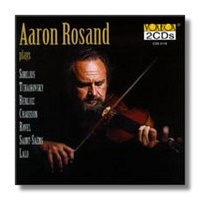
The Internet's Premier Classical Music Source
Related Links
- Latest Reviews
- More Reviews
-
By Composer
-
Collections
DVD & Blu-ray
Books
Concert Reviews
Articles/Interviews
Software
Audio
Search Amazon
Recommended Links
Site News
 CD Review
CD Review
Aaron Rosand Plays

- Jean Sibelius: Six Humoresques, Op. 87/89 *
- Piotr Ilyitch Tchaikovsky: Sérénade mélancholique, Op. 26 *
- Hector Berlioz: Rêverie et caprice, Op. 8 *
- Camille Saint-Saëns:
- Introduction & Rondo capriccioso, Op. 28
- Concerto #3 in B minor, Op. 61
- Havanaise in E Major, Op. 83
- Ernest Chausson: Poème, Op. 25
- Maurice Ravel: Tzigane (Rhapsodie de concert)
- Édouard Lalo: Symphonie espagñole, Op. 21
Aaron Rosand, violin
* Southwest German Radio Orchestra, Baden-Baden/Rolf Reinhardt
Southwest German Radio Orchestra, Baden-Baden/Tibor Szöke
VoxBox CDX5116 1995 ADD 2CDs 70:58; 70:41
There's a lot of good violin music in Aaron Rosand's VoxBox 5116, and if none of it seems new or unusual now, think of the impact the original recordings must have had when they were made in 1957-59. Who then had recorded all of Sibelius's Humoresques, Berlioz's Rêverie, or even Lalo's complete Symphonie espagñole? For many years, it was Aaron Rosand who kept the fringe of the violin repertoire from crumbling away. His was the only recording of the once-popular Ernst Concerto in F# Minor. And he dared to make a recording of all of Sarasate's Spanish Dances. He was an able apologist as well, defending his repertoire in jacket notes as eloquently as he played it in the recordings themselves. If Rosand wasn't the greatest violinist ever to perform these pieces, he was certainly a sympathetic and skilled champion, and nobody who listened to him could fault him for following the path he had chosen.
The Rosand miscellany in question contains some fine violin playing. Sibelius's Humoresques may have sounded jauntier in the hands of Salvatore Accardo, but Tchaikovsky's Sérénade has never been never more passionately plaintive, even in Heifetz's version, which sounded merely whiny.
Berlioz's Rêverie supports the violin part with characteristically transparent orchestral textures. Although the solo writing recalls the viola of Harold in Italy, the composer allows just a bit more virtuosic display. If he had written the first movement of Harold in Italy in a similar vein, Paganini might not have rejected it out of hand. Rosand provides enough color to balance the accompaniment.
If there's anything to complain of here, it's Rosand's tendency to play with consistently beautiful tone, perfect articulation, and immaculate intonation. The result is clinically cool, each work reduced to a denominator as common as it is congenial. The Introduction and rondo capriccioso, for example, is so frequently played that it's hard to introduce a personal element. Some artists have nevertheless imposed a proprietary stamp: Heifetz's was coolly elegant; Rabin's, warmly smoldering. Rosand's is less individual. It's also far from being mechanical. Nevertheless, when listening to Rosand, as to many violinists who came after him, esthetic expectations must be modified. Not always, perhaps, for he plays Ravel's Tzigane with just the right kind of deadpan virtuosity. But sometimes you miss the overarching idea behind the work. It's hard to imagine when listening to his account of the Havanaise that Saint-Saëns conceived it while watching a crackling fire on a cold, rainy night.
Saint-Saëns's third concerto and Lalo's Symphonie espagñole require just the kind of bold attack that is Rosand's stock in trade. Neither is long on subtlety, but then, Rosand isn't, either. They are therefore excellent vehicles for his talents, and he does them more than ample justice. In fact, it's hard to imagine a more rousing, dazzlingly virtuosic and visceral rendition of the Symphonie espagñole.
The recordings are uniformly clear and rich in detail – truly amazing for their vintage. At Vox's prices, a collection like this one by an estimable violinist like Rosand is well-nigh irresistible. Think of it this way: for almost nothing, you can get one of the best Lalos ever recorded and about an hour and a half of music absolutely free. A phenomenal bargain!
Copyright © 1996, Robert Maxham


















